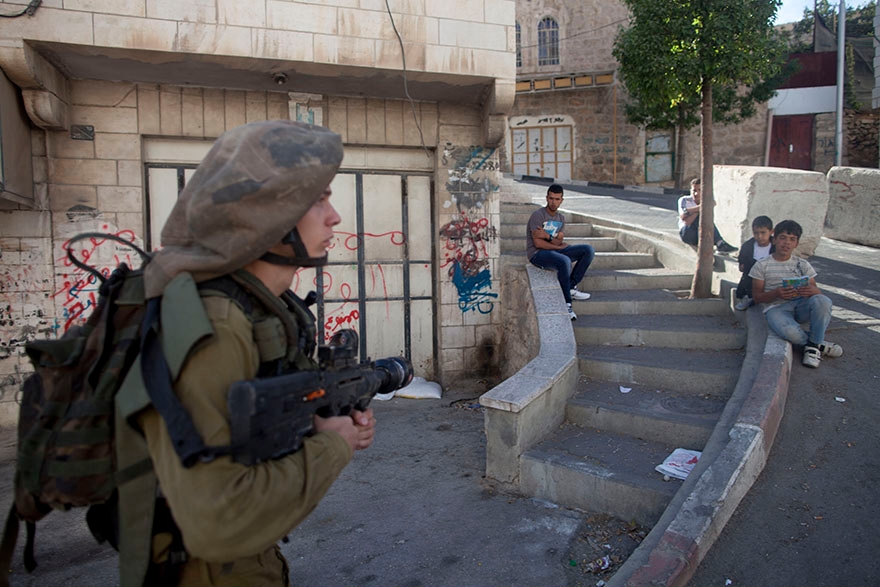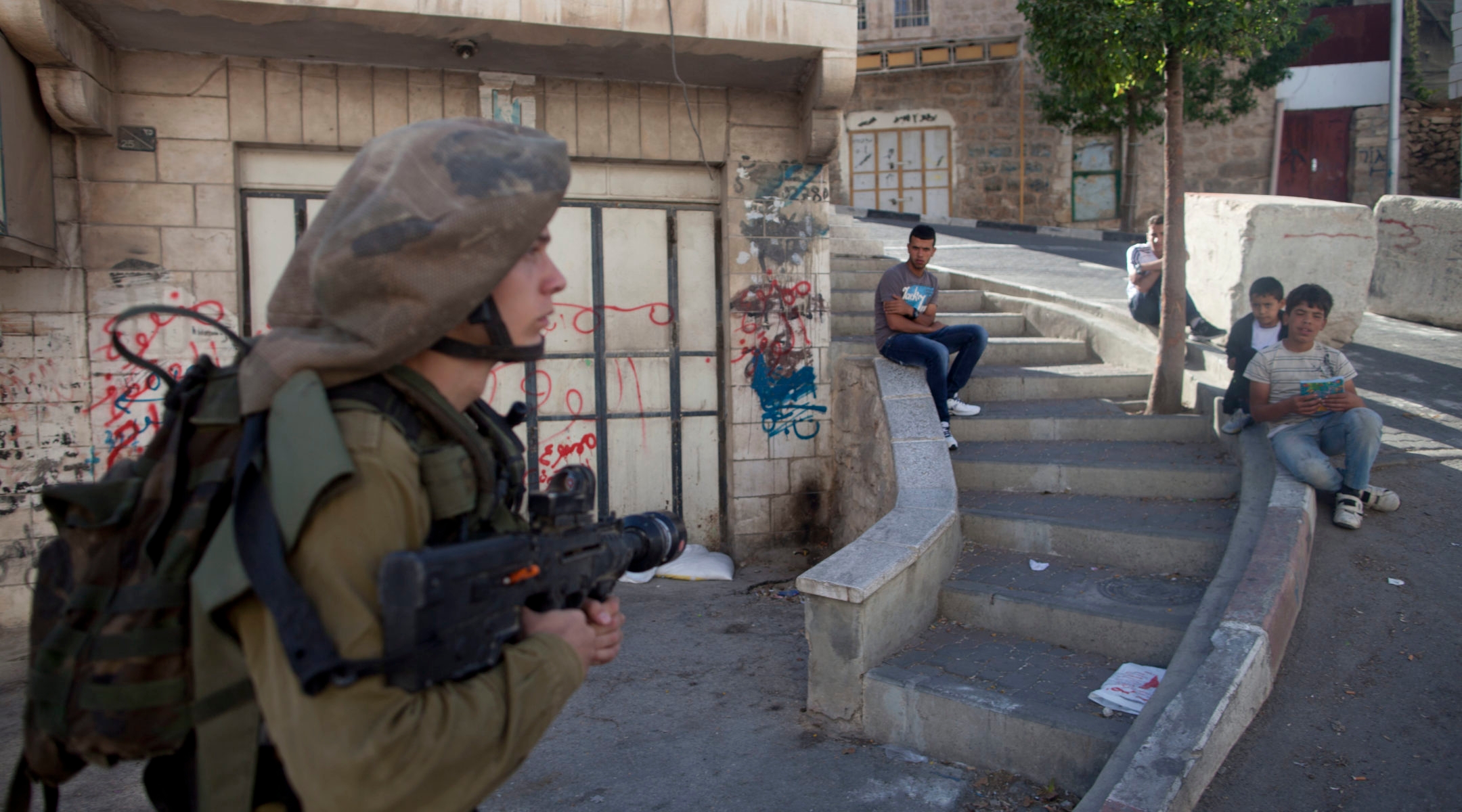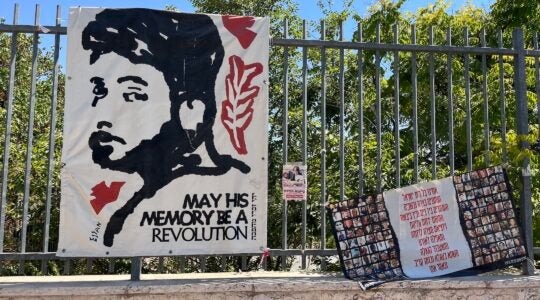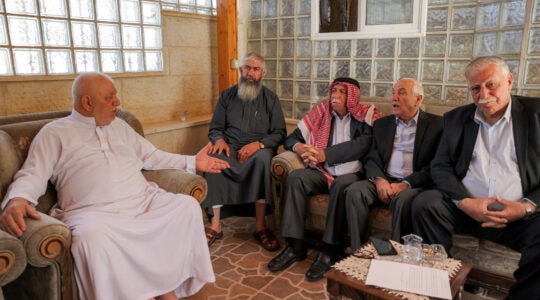
Palestinians watching an Israeli soldier on patrol in a street on September 23, 2013 in Hebron. (Photo by Lior Mizrahi/Getty Images)
(JTA) — The heritage committee of the United Nations Educational, Scientific and Cultural Organization, or UNESCO, passed a Palestinian-led motion calling Hebron’s Old City an endangered heritage site despite protests by Israel and Jewish groups.
Israel reacted with fury, with Israeli Prime Minister Benjamin Netanyahu calling the resolution “delusional.”
The resolution passed in a secret vote in Krakow, Poland on Friday with the necessary two-thirds majority. According to reports, Israel and the United States had requested the secret vote in hopes of attracting votes from countries that might otherwise have incurred Arab anger for voting against the resolution.
The resolution notably does not describe Hebron as in Palestine, although it notes that the “permanent delegation of Palestine” submitted the request. It does not mention any Muslim, Jewish or Christian claim to the city and simply determines that the site is eligible for designation as a world heritage site and also merits inclusion on UNESCO’s “in danger” list.
It “regrets” that Israel would not allow inspectors from the International Council on Monuments and Sites, which advises UNESCO on heritage designations, to access the site and acknowledges that as a result, ICOMOS was not able to “fully evaluate” whether the site “unquestionably” merits the designations.
The resolution uses two names for the city: Al Khalil, the Arabic name, and Hebron, which is used in the West and which is close to the Hebrew “Hevron.”
UNESCO’s online report of the resolution’s passage refers in its introduction to Hebron as being in Palestine.
The online report, appearing to use language in the ICOMOS report but not in the resolution, dates the Old City’s central attraction, the compound of the Cave of the Patriarchs, to the 1st Century CE, describing it as built “to protect the tombs of the patriarch Abraham / Ibrahim and his family,” again using the Arabic and Western terms for a biblical name (in Hebrew, Avraham.) It describes the cave (also known to Jews as the Cave of the Machpela) as “a site of pilgrimage for the three monotheistic religions: Judaism, Christianity and Islam.” It also notes Islamic era architectural developments in the city.
The ICOMOS report delves in some depth into the city’s origins. It notes the ancient origins of Hebron’s Jewish community and that Jews left the city “after the eruption of violence in 1929,” an allusion to the massacre of 69 Jews that year by Palestinian nationalists.
Before the vote, Israel’s foreign ministry and Jewish groups urged the members of UNESCO’s World Heritage Committee to vote against.
Subsequent to the resolution, Netanyahu called it in a Facebook posting “delusional” and said that “this time they determined that the Cave of the Machpela is Palestinian, meaning it is not Jewish.”
In fact, the resolution did not mention the Cave of the Machpela, and does not designate the site as Palestinian; Netanyahu may be inferring that designation based on the committee’s decision to accept a request from the “state of Palestine.” (UNESCO is one of the only international bodies to recognize Palestine as a state.)
Nevertheless, organizations like the World Jewish Congress insisted the resolution, in the words of WJC CEO Robert Singer, denied Hebron’s “historic and religious importance to Jews and Christians.”
Netanyahu also in a statement said he would cut $1 million from Israel’s contribution to the overall U.N. budget, and dedicate it to “Jewish Heritage Projects in Hebron and Kiryat Arba,” a nearby Jewish settlement. Haaretz reported that Avigdor Liberman, Israel’s defense minister, called UNESCO “anti-Semitic.”
Israeli troops heavily guard Hebron’s small Jewish community, and control access to holy sites there considered sacred by Jews, Christians and Muslims.
ICOMOS, explaining its recommendation to list the site as “in danger,” cited reports from the Palestinian Authority that Israel was preventing restoration to some of the Old City’s ancient structures and that it had unilaterally altered the Cave compound. Israel says its guardianship of the site is sensitive to the sensibilities of all three faiths. “It is only in those places where Israel is, such as Hebron, that freedom of religion for all is ensured,” Netanyahu said in his Facebook posting.
On Tuesday, the heritage committee of UNESCO passed a resolution submitted by the council’s Arab states rejecting Israeli sovereignty over Jerusalem. Ten countries voted for the resolution with three opposed and eight abstaining.
Calling Israel the “occupying power,” the measure said the U.N. body “regrets the failure of the Israeli occupying authorities to cease the persistent excavations, tunneling, works, projects and other illegal practices in East Jerusalem, particularly in and around the Old City of Jerusalem, which are illegal under international law.”
American Jewish groups had advocated against both resolutions. Subsequent to Friday’s Hebron resolution, the American Israel Public Affairs Committee posted on Twitter, “#UNESCO’s second anti-Israel resolution in less than a week.”
JTA has documented Jewish history in real-time for over a century. Keep our journalism strong by joining us in supporting independent, award-winning reporting.






